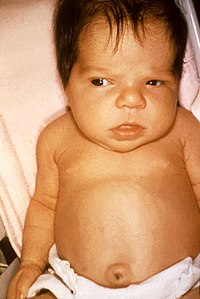
Photo from wikipedia
Background: Neonatal hyperbilirubinemia is a frequently encountered problem. Erythrocytes, especially reticulocytes are rich in copper (Cu) and magnesium (Mg) so its serum levels increase after hemolysis. Zinc (Zn) plays an… Click to show full abstract
Background: Neonatal hyperbilirubinemia is a frequently encountered problem. Erythrocytes, especially reticulocytes are rich in copper (Cu) and magnesium (Mg) so its serum levels increase after hemolysis. Zinc (Zn) plays an important role in synthesis of some enzymes included in the bilirubin metabolism and may cause hemolysis. Exchange transfusion is the main treatment for severe neonatal hyperbilirubinemia but can exchange transfusion affect the previous trace elements. Materials and Methods: We measured Cu, Zn, and Mg serum levels in full-term neonates admitted to neonatal intensive care unit of Minia University hospital with severe indirect hyperbilirubinemia before and after exchange transfusion. Results: There were significant higher serum Cu and Mg and lower Zn serum levels in neonates with hyperbilirubinemia than controls and their levels were significantly normalized after exchange transfusion. Significant positive correlations between the total bilirubin levels and hemoglobin, Cu and Mg serum levels and significant negative correlations with Zn levels were present. There were no significant correlations between maternal and neonatal serum levels of any of them. Conclusions: Exchange transfusion can normalize the significant higher Cu and Mg and lower Zn serum levels in neonates with severe indirect hyperbilirubinemia which were not related to their maternal serum levels.
Journal Title: Journal of Pediatric Hematology/Oncology
Year Published: 2018
Link to full text (if available)
Share on Social Media: Sign Up to like & get
recommendations!